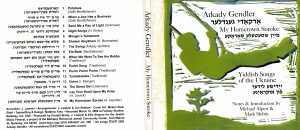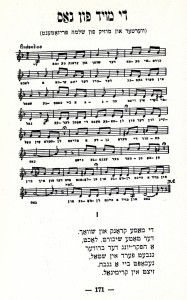This is a song from Arkady Gendler, a Bessarabian Yiddish singer born in 1921 in what is now Ukraine. In 1999, I was lucky enough to accompany Arkady on the accordion when he sang
at the Jewish Music Festival in Berkeley. Before he came, accordionist Jim Rebhan & I transcribed Arkady’s repertoire from a noisy cassette tape of him singing, unaccompanied, late at night, about 15 songs. We put all the charts together into a book & took turns playing with Arkady in concert.
Arkady was & is a mentsh–white-haired, courteous, oysgepitst in suit & tie for every concert. His whole family died in the Holocaust. Under the Soviets he worked as a plastics engineer while maintaining an underground Yiddish school. He sings in the old style, allowing room for breath & for dramatic pauses, so a musician who is trying to count might complain that Arkady’s not keeping the beat. But there’s a deep internal rhythm in his singing — not the slavish square rhythm required for most written music, but the flexible, responsive, shifting rhythm of living language.
One of the festival’s directors–Donald Brody–was so taken with Arkady’s singing that he insisted we make a recording. And so we did–at Fantasy Studios–two hours before Arkady left for the airport. We did it live, in one room, with one stereo microphone, one take of each song, sixteen songs.
It was Jim Rebhan who first identified this song as a tango.
I was so unhip, I kept trying to play it as a waltz. Unfortunately, I’m the one who plays it on the recording–Jim couldn’t get off work. Arkady introduces it by saying that it’s a mashup of two songs he heard in the Yiddish theatre in Poland between the two World Wars. He says that smalltown girls going to the city for work often found themselves involved in “the world’s oldest profession,” & he hopes that singing about it won’t shock anyone.
Di moyd fun gas (The Street Girl)
It still kills me that Jim’s not on the recording. He is an easy, flowing player who can do all sorts of pretty flourishes. On most of the CD, & during the concerts, I just laid down the basic chords, watched Arkady’s breathing, & tried to stay out of the way. On this track, I would say, I didn’t succeed–but Arkady didn’t let that bother him.
Ten years later, I was still mulling over this song & its proper form. I really loved the story of a street girl who makes a living dancing & singing & who knows what else, knowing perfectly well that she’ll probably die alone in a hospital bed & be buried without a tombstone “unter a ployt”–that is, under a fence, outside the cemetery, in unholy ground. She says, “Who’s going to come say Kaddish for me — a nekeyve?” Most Yiddish dictionaries define “nekeyve” as an insulting word for female, but a woman in a workshop on underworld songs said it means, literally, “a hole.” So this girl knows that’s all she is to her audience–but she goes on singing & dancing anyway. She says, “Ven ikh vil zayn shoyn alt, un darfn geyn mayn letstn gang, vet in zikorn aykh blaybn mayn letster tants!” (When I get old, & have to make my last exit, you’ll keep the memory of my last dance!)
During those ten years, I moved to New York & met Jenny Levison, a Yiddish singer & tango dancer who’d gone to the YIVO in Buenos Aires & collected words & music to almost 200 Yiddish tangos. She asked me to play in the Yiddish tango theatre piece she made, & so I got to play & travel with her band, including violinist Jenny Scheinman & the tango bassplayer/arranger/bandleader Pablo Aslan, from Argentina. Jenny L. said that smalltown Jewish girls from Eastern Europe, at the turn of the 20th century, often went to Buenos Aires expecting to find work or marriage, only to be turned into whorehouse sex slaves. (You can see their pictures in the back of any newspaper today, among the sex ads of desperately smiling girls from Russia & Asia.) Argentina didn’t have immigration quotas, so a lot of Jews settled there. The combination of Yiddish song, gaucho culture, bordello entertainment & versatile musicians gave rise to many beautiful Yiddish tangos.
In NY I also volunteered at the YIVO music archive, where Lorin Sklamberg set me to cleaning records with their special archival record-cleaning turntable. You have to put each & every record on the turntable & lower an arm which, while the record spins, squirts the vinyl with record cleaner instead of playing it with a needle. It was in a room full of donated records & Lorin let me play music while I was working. In a box of donated 78s I found one called “Vagabondlid,” by Max Zalkind y Su Orkestra Tipica, from Argentina.
When I figure out how to make cassettes into digital files, I’ll put the “Vagabondlid” up on this blog. Because the first lush strains of the Orkestra Tipica (trumpet, clarinet, strings, piano) were the chorus of Arkady’s “Moyd fun gas,” played not as a tango, nor as a waltz, but as a rhumba.
NY is where I also met Itzik Gottesman, a third-generation Yiddishist. In his office at the Yiddish Forverts newspaper he kindly answered all my questions about authorship of Arkady’s songs for the liner notes of the CD. Itzik said his mother, Beyle Schaechter-Gottesman, also sings the “Vagablondlid,” but differently from Arkady; her version is more like the one Zalkind recorded. Before I moved back to California, Itzik gave me a Yiddish book from Argentina: Shloyme Pryzament’s collection of songs sung by & about the Broderzingers.

"Broderzinger" by S. Pryzament, published in Buenos Aires in 1960 by the Central Union of Polish Jews in Argentina
Pryzament includes a number of songs about the Yiddish underworld: “Der vanderer” (The wanderer); “Tsigayner-lid” (Gypsy song); “Der gonif” (the thief); “Der shiker” (the drunk) & then–I read it twice–“Di moyd fun gas.”
Pryzament gives yet another variant, & lists himself as author, publishing in 1960. So where did the song come from? How did it reach the Polish-Yiddish theatre where Arkady heard it in between two world wars? What was the other song that he heard at the same time, which stuck in his memory & mixed itself up with this one? Was it called “Mayn letster tants?” Was it written by the Yiddish soubrette who danced across the stage and into our group mind?
Is there a recording somewhere, in a dusty attic or moldy basement, or in a box of YIVO donations?
Lorin Sklamberg is still archiving donations at YIVO, so maybe it will turn up. Menawhile, he’s got a nice blog.











